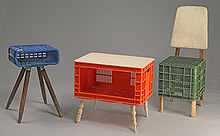Milk crate


Milk crates are square or rectangular interlocking boxes that are used to transport milk and other products from dairies to retail establishments. Middle 20th century ones were made of wood, later ones were stainless steel, and those made in the latter part of the century were of heavy-duty polyethylene. In English-speaking parts of Europe the term "bottle crate" is more common but in the United States the term "milk crate" is applied even when the transported beverage is not milk.
The most common milk crate sizes are square crates that hold four 1-gallon milk jugs (12 inches by 12 inches inside dimensions) and rectangular crates that hold six 1-gallon milk jugs (18+1/4 by 12 inches inside dimensions).[1]
Milk crates are often stolen for either personal or business use or for the plastic that they are made out of. Theft of milk crates can cost dairies millions of US dollars per year.[2] This has led at least one dairy farm to hire a private investigator to discover what is happening to the crates;[3] the results of investigations point to plastic re-sellers being the culprits in the majority of thefts.[4]
In July 2008, Wal-Mart and some other stores introduced a square milk jug that does not need to be transported in a crate. Sometimes called "green" milk jugs, they are not green in color, but rather are claimed to be environmentally friendly. These new milk jugs are stackable, and can be transported without crates. Companies need not buy plastic for the crates, nor transport or wash them.[5]
See also
References
- ↑ "About Farmplast"
- ↑ Police ask: got milk crates?
- ↑ News report on stolen milk crates
- ↑ Los Angeles County Crate theft
- ↑ DailyTech - Cheaper, Stackable, "Green" Milk Jugs Cause a Stir